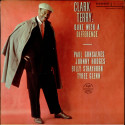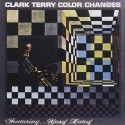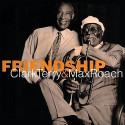Clark Terry
| Track | Album |
|---|---|
| Song Of The Islands | America's #1 Band |
| Mood Indigo | Duke With A Difference |
| Slow Boat | Clark Terry |
| Stardust | Serenade To A Bus Seat |
| In Orbit | In Orbit |
| Brother Terry | Color Changes |
| Brotherhood Of Man | Oscar Peterson Trio + One |
| Step Right Up | Tonight: Clark Terry-Bob Brookmeyer Quintet |
| On The Trail | Clark Terry And His Jolly Giants |
| For Dancers Only | Friendship |
Contributor: Calvin Rydbom
I’ve been meaning to finish this piece for about two years, I just never really got around to it. I started it after going to see Keep On Keepin’ On released in late 2014, which was a documentary about Clark Terry, but more so about his history of mentoring young musicians. And of course he passed away in early 2015. The film itself covered his mentoring approach, starting with a 12 year old horn player named Quincy Jones and ending with a barely 20 blind piano player named Justin Kauflin, and covered a lot of years in between. Although the film did end with Terry in bed, both of his legs amputated from diabetes, coaching a horn player sitting at his bed side.
The happiest sound in Jazz, that’s what they called him. He played relentlessly cascading bright, clear notes with a stunning velocity which made him Dizzy Gillespie’s favorite trumpet player. He also often picked up the rounder-toned flugelhorn making his sound even more identifiable and did a lot to popularize the instrument among serious musicians.
He played with both Count Basie and Duke Ellington during the 1950s and became the first African-American musician to be hired full-time by the National Broadcasting Company when he joined the Tonight Show Band from 1962-1972.
Nobody is really all that sure how many recordings he appeared on, but about 900 seems to be the best guess.
His list of awards is endless. Sixteen Honorary Doctorates, French Order of Arts and Letters, Jazz Ambassador for US State Department tours in the Middle East and in Africa while performing for eight Presidents. Although my favorite is a knighthood in Germany, I didn’t even know Germany had knighthoods until I read about it.
He was also known as a great duet partner, releasing countless duet albums over the years with numerous partners. Some covering decades.
When Terry passed away last year Martin Chilton of The Daily Telegraph wrote “Terry was a music educator and had a deep lasting influence on the course of jazz. Terry became a mentor to a generation of jazz players, including Miles Davis, Wynton Marsalis and composer-arranger Quincy Jones.”
He first came to prominence in the late 1940s and early 1950s as a member of Count Basie’s Orchestra, but in that large ensemble he was just another guy in the trumpet section. It was within the octet groups that Basie put together where Terry really was able to show his stuff. The Basie Octet, with a four-piece rhythm section and a four piece horn section, featured Basie, guitarist Freddie Green and the great clarinet player Buddy DeFranco as well as Terry.
Song Of The Islands from 1950 is an Octet piece where the horn sections certainly steal the thunder from the rhythm section. Terry and DeFranco weaved around each other in a clear foreshadowing of Terry’s long string of duets in the future. And while saxophonist Wardell Gray doesn’t quite reach their peaks he certainly holds his own in this early recording of Terry.
Sometimes when writing a Toppermost article you find yourself trying to make sure every era of a musician’s career is included, and while that doesn’t really lower the quality of the ten songs, it does change they way you put together your list.
I only mentioned that as it’s really impossible to talk about Terry’s career without including at least one Basie and one Ellington cut. And I had some trouble choosing my favorite Ellington cut, which I knew was all the room I’d have as I still had the Bob Brookmeyer and Oscar Peterson partnerships to deal with later, and that wasn’t even getting into his solo work, And I knew what the last cut would be.
So that brings us to 1957, by which time Terry was also often serving as an arranger for Ellington. The classic Duke With A Difference saw him acting as the arranger on six of the eight tracks with Mercer Ellington handling the other two. Mood Indigo stands out among a group of eight standouts. How did Terry, Johnny Hodges, Paul Gonsalves and Billy Strayhorn among others all show their chops but give each other such space? An amazing rendition of the Ellington classic.
Off of his first solo recording comes Slow Boat. It’s somewhat unusual for a musician to have achieved their full sound by their initial solo recording as Terry does here, of course it doesn’t hurt that his band included Oscar Pettiford, Art Blakey and Horace Silver. He was also smart enough to give Pettiford and Silver time to solo, and didn’t just give the spotlight all to himself. Yet his solo on the piece is still fantastic. As I said though, it didn’t hurt of course to have a band featuring a bunch of men hitting their peak who would all eventually become household names in the jazz world.
I remember being somewhat shocked when I first heard Terry’s 1957 rendition of Stardust. I was sort of mentally invested in the “happy sound” by that point, and while I shouldn’t have been, was surprised with how good he handled a melancholy ballad. His playing on this track is wonderful in a soft lush sort of way, which is utterly in contrast to a really ferocious solo by saxophonist Johnny Griffin. It worked.
When I bought the album In Orbit as a cassette in around 1980 it was probably my first Terry album. I bought it not because I was all that aware of Terry, or the cassette called itself out as a great Terry album, but because the cover announced itself as Monk’s last album as a sideman.
The title track, also featuring Sam Jones and Philly Joe Jones, is some of the hardest swinging work that you’ll find in Monk’s catalog. I’d say it was rivaled only by his Giants of Jazz work with Dizzy and Blakey in that sense. It really seems that Terry’s tone, which here was the kind of tone that gave him the happiest reputation, pushes Monk into the phrasing that is heard here and was a rarity for Monk. As well as a rarity for this period in jazz.
My favorite album by Terry was 1960’s Color Changes. I think his round and full sound reached its full maturity on the album, and Brother Terry for me is the highpoint, mostly because he is able to fit everything that needs to be said in under four minutes.
Terry had a long partnership with pianist Oscar Peterson. I remember reading somewhere, and I’m afraid I can’t give credit, that putting Terry and Peterson together with Ray Brown and Ed Thigpen had to break some sort of law concerning the amount of swing allowed in a song. There are so many standout tracks on this album, but I prefer Brotherhood Of Man. This is one time where I step out on my own as a lot of Terry and Peterson’s fans prefer a few other of the album’s tracks, specifically Squeaky’s Blues. Me? I just find Brotherhood Of Man to have an explosive feel to it I can’t get over. The album was also the introduction of the Mumbles persona that became part of Terry’s repertoire. And you have to cite that as an important moment in Terry’s career.
Another long time musical partner for Clark Terry was valve trombonist Bob Brookmeyer. Terry had sort of evolved into a bit of a modernist by the 1960s, and it was then I think he was at his best in contrast to Brookmeyer’s hard swinging style. Step Right Up from 1967’s Clark Terry-Bob Brookmeyer Quintet is some of the best work by either artist. They find that middle ground within their styles that made their shared catalog so good. And it’s one of the swingingest solos in Terry’s long career. That’s a bold statement I know, but I believe it.
By the 1970s “The Happiest Sound in Jazz” had become the center of Terry’s sound and relationship with his listeners, almost too much the center really. In 1975 he recorded On The Trail with his Jolly Giants which could have come off as too cute but didn’t. It had the happy sound of course, how could it not with a band called the Jolly Giants. And there was that signature move from the period where he traded off between the flugelhorn and a muted trumpet. But it worked well here, really well.
I’ve mentioned Terry’s talent at duets several times already. I really wanted to choose something from his late career duets with bassist Red Mitchell, but I couldn’t bring myself to do it. Mostly because of the 2002 album Friendship with Max Roach.
You see it was Roach’s final recording and among all the jazz giants my favorite is Max. He was ill here, and didn’t play on another released track for the last five years of his life. So perhaps the cut For Dancers Only isn’t as heartwarming and beautiful as I think it is. Maybe Terry’s joyful sound doesn’t inspire Max to be the greatest musician to choose the drums as his primary instrument one last time. I just know it’s in my top ten Terry pieces because of what it is. It’s Max’s last statement.
When it’s all said and done, Clark Terry deserves the title the happiest sound in jazz. And while I didn’t really get into it too deeply he was also one of the great mentors in jazz.
“Keep On Keepin’ On” – Clark Terry documentary
Clark Terry biography (Apple Music)
This is Calvin’s 30th Toppermost. His third book “Modern Images of Akron” was recently released by Arcadia Publishing. In it Calvin spends a good deal of pages covering the history of music in Akron with images and commentary on the Black Keys, Devo and Pretenders among others. He has also recently signed on to be the Archivist and Contributing Author for the proposed Akron Sound Museum, which will celebrate the history of Akron Music from the early 1960s to present. In the meantime he is working on his 4th book before starting a fifth on the history of Akron Music. Read Calvin’s toppermost on Max Roach here.
TopperPost #520









Excellent. I only have one instance of Mr. Terry in my small jazz collection.. in the band on the Tubby Hayes disc “Tubbs in NY”. This top ten will be good listening.
Hope you enjoyed it Keith.